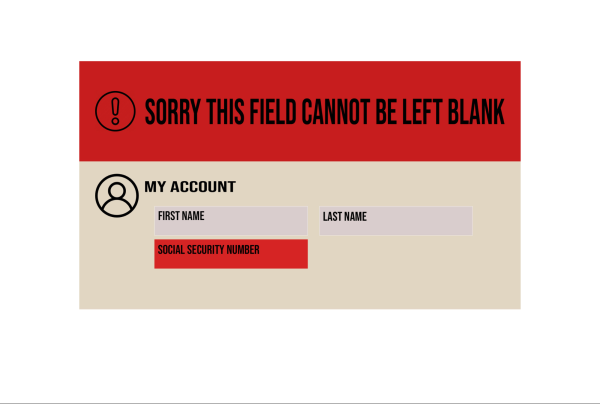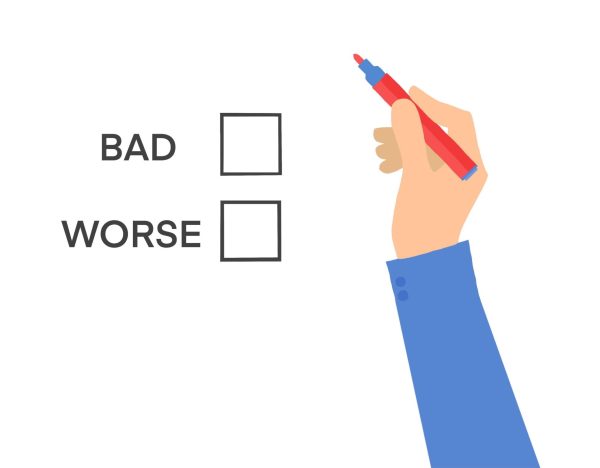One size certainly does not fit all
Navigating testing maze difficult for students with dyslexia, testing anxiety
October 10, 2017

I sit down in a crowded ACT testing room at Anderson High School.
I’m wearing what every girl there is wearing. An oversized sweatshirt with an oversized T-shirt, athletic shorts and running shoes. I have my TI-84 Plus graphing calculator, with fresh batteries to my right, and three freshly sharpened No. 2 pencils to my left. I look confident on the outside. I’ve been going to ACT tutoring for several months, have done countless practice tests, and had a full nine hours of sleep and a healthy breakfast.
I should feel confident on the inside, but I don’t. I feel a fresh wave of testing anxiety wash over me as the test proctor walks around with all of our testing booklets, riddling off rules of what to and not to do in the testing room. I mentally tell myself, “I got this, I’ve been practicing for this for months and I’ve already taken this test before.” But honestly, I really do not feel like I got this. Unfortunately, for millions of similar dyslexia and test anxiety-ridden kids in America, this is the reality we face every time we have to take the ACT or SAT.
I was diagnosed with dyslexia in first grade. My teacher noticed I was reading at a slower rate than the rest of the class. I was having a harder time understanding simple concepts that other kids were getting easily. This diagnosis put in motion a process that I have been battling my entire life. After second grade, I was moved to a private school where my grade included only 20 kids. There were only five-to-10 students in each class. This was the environment that I needed at that point in my life.
I had a tutor that I went to every day in order to work on my sight-reading and spelling skills. It took a lot of work but after two years of schooling in this tiny, isolated and individualized environment, I was ready to move to a larger school where everything was a bit less structured, but it was still a private school that offered one-on-one tutoring, just less often. I was doing well with the amazing teachers and a tutor that I saw twice a week for homework help.
Eighth grade came and went, and I headed to McCallum, a large public high school, after being out of the public school system for six years. I had an older brother who was a senior to help me through freshman year, and thankfully my best friend was also going to McCallum, but the increased workload was a burden I was not ready to bear.
I was taking four Pre-AP classes as a freshman because I didn’t know any better. I thought I would be able to adjust to high school rather easily, but unfortunately it was harder and took longer for me to make the transition. I had to learn my first couple of years of high school how to be an advocate for myself, something I never really had to do at a private school where everyone was in the same boat as me. Now in high school, I was in the minority. Although many students have learning disabilities, most do not.
As junior year came, the idea of college came up more and more. My mom is ultra hands on, not only making sure I am prepared for school but also thinking about my college career, which was still 18 months away when she first brought it up. Before she raised the subject, I didn’t think about it too much and just tried to focus on my challenging junior year course load.
As the spring semester came around, my mom told me I needed to sign up for ACT tutoring sessions to prepare for the April test. I begrudgingly agreed, knowing I would burn a lot of gas driving myself to north Austin two or three times a week for six weeks before the test, but I kept to the plan because after all, it’s all for my future, right? I tell myself over and over again that this IS my future, and I need to focus on it and devote the extra 30 minutes of free time necessary to complete 25 extra reading problems, or whatever section I was struggling with that week.
But I was exhausted for the last few months of junior year. I felt like I was one step behind everyone when it came to the ACT. Because of my dyslexia, it was taking me much longer to process a reading passage or to comprehend a science problem.
My tutor instructed me to just take five hours one Saturday and take a test all the way through. I locked myself in a room in my house put my phone away and powered through it. The ACT is graded on a system from 0-36 for your composite score. My goal for the practice test was to get a 26. I got a 27. OK, I thought, this is awesome. If I can score that well at home, then I bet I am going to kill it once it comes to testing day. There’s only one problem: test anxiety.
Fast forward to testing day at Anderson. I’m so nervous my stomach is in knots. I try to tell myself over and over again that it really is OK to do poorly; I can always retake it. But talking myself down doesn’t work. I am so anxious and I can’t help but think to myself that so many other people in here must be nervous too, right? I later found out that millions of kids in America have testing anxiety and dyslexia, but the emphasis on multiple-choice tests like the ACT and SAT is still just as high.
It is as if many college admissions offices just don’t know or don’t care that testing anxiety and testing disabilities are real issues that disproportionately affect some college-ready high school students. This mentality must change.
The truth for me is that my grades in high school have been good, but I have had to work incredibly hard for them to get there. Junior year, and at the beginning of senior year, I do not go off campus to get lunch, but rather, I go to my teachers’ classrooms and do countless rounds of test corrections or trying to understand a concept that I just for the life of me I couldn’t understand in class. I wish I could show colleges a log of the amount of time I spend at school. I wish they would care more about the fact that I am an advocate for myself and constantly looking to better my grades and scores, instead of forming a first impression about me based on the number I post on the 0-36 ACT scale.
There have been some positive changes in the past couple of years. Colleges are emphasizing that they are taking a more wholesome approach to reviewing applications. This wholesome approach that colleges are touting, however, still starts with reviewing your test scores, which can either be a good first impression, or if you’re like me and suffer from dyslexia or testing anxiety, a bad one.
Another option would be to make test scores optional to send to schools. Small liberal art schools already make it optional for applicants to submit test scores, but students like me who are applying to large state schools and universities, still must send in their test scores, no exceptions.
But no matter the school’s size or its admissions policy, a score on a multiple-choice exam does not in any way reflect what we know and should never be the first thing that college sees when forming a first impression of a student applicant.














